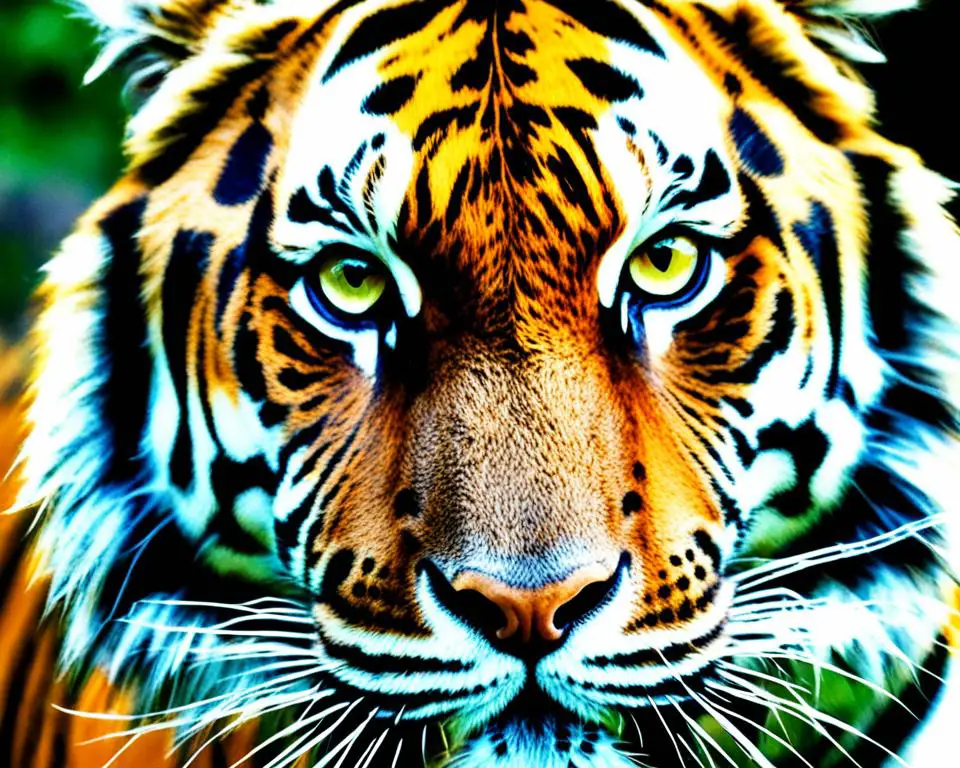Imagine stepping into the vibrant wilderness of the Indian subcontinent, with its lush forests and warm grasslands, where you might catch a glimpse of the majestic Royal Bengal Tigers in their natural habitat. Magnificent and powerful, the Panthera Tigris Tigris reigns supreme – a symbol of India’s rich biodiversity and the embodiment of wildlife wonder.
Regrettably, as you marvel at the grandeur of these resplendent creatures, it is with a hint of melancholy. These proud members of the big cat family are an endangered species, facing the daunting challenges of habitat loss and the specter of poaching. Yet, their beauty and strength continue to captivate us, reminding global wildlife enthusiasts and conservationists alike of the critical need for urgent action to ensure their survival.
Your connection with these tigers goes beyond admiration; as India’s National Animal, they hold a special place in the heart of the country’s cultural heritage. Their continued existence is not just a matter of national pride, but a pivotal factor in the health of the ecosystem they rule. Join us as we delve into the awe-inspiring world of the Royal Bengal Tigers, creatures of beauty, might, and importance that stand as guardians of the wilderness.
Understanding the Royal Bengal Tiger’s Scientific Classification
As you immerse yourself in the enchanting world of the Panthera Tigris Tigris, it’s essential to understand its place within the scientific realm. This remarkable species is not only a symbol of wild grandeur but also an intricate part of the taxonomic classification system that helps us study and conserve these big cats effectively.
Belonging to the animal kingdom, the Royal Bengal Tiger stands out as a top predator within the Order Carnivora. Known for its strength and agility, the tiger is a member of the Felidae family, showcasing characteristics such as retractable claws and powerful physiques optimized for hunting. Embrace a clearer view of this apex predator’s classification with the table below:
| Taxonomic Level | Classification |
|---|---|
| Kingdom | Animalia |
| Phylum | Chordata |
| Class | Mammalia |
| Order | Carnivora |
| Family | Felidae |
| Genus Species | Panthera tigris |
Your journey through the tiger’s taxonomic tree reveals its evolutionary relationship with other carnivorous mammals. The genus Panthera links tigers to other big cats like lions, leopards, and jaguars, highlighting shared traits and behaviors that are crucial to their survival. As you explore further, bear in mind the Royal Bengal Tiger’s vital role in its habitat and the larger ecosystem – a true emblem of nature’s intertwined complexity and beauty.
The Physical Grandeur of Royal Bengal Tigers
As you delve into the striking world of the Royal Bengal Tigers, it’s impossible not to be awestruck by their formidable size and commanding presence. These apex predators are not only a testament to the power and majesty of nature but also exhibit fascinating physical characteristics that vary by gender, are marked by unique stripes, and sometimes result in captivating color variations due to rare genetic mutations.
Impressive Size and Weight Differences Between Genders
One of the most striking aspects of the Bengal Tiger size is the discernible differences between males and females. Males of this species display significant bulk and length, tipping the scales at up to 500 lbs. with an awe-inspiring reach of nearly 10 feet. Females are relatively smaller, weighing up to 300 lbs. and measuring approximately 9 feet in length. This difference in dimensions underlines the gender differences inherent to these tigers and contributes to their distinct roles within their habitat.
Unique Coat Patterns: Stripes as Their Fingerprints
While the size tells a story of strength, the Royal Bengal Tiger’s coat tells another about uniqueness. Each tiger is adorned with a pattern of stripes that is exclusive to them, serving as a natural fingerprint. These unique stripes are not merely aesthetic; they play a critical role in their survival by providing a camouflage that seamlessly blends into the grassy or forested backdrops of their hunting grounds.
Color Variations: The Mystery Behind White Bengal Tigers
The existence of white Bengal Tigers adds a layer of mystery and allure to the species. This ghostly variant showcases a snowy coat contrasted with dark stripes – a breathtaking sight indeed. Far from being albinos, these white tigers are the result of a gene mutation that affects pigment production, while their arresting blue eyes and jet-black stripes remain as identifying features, sharing the genetic blueprint of their conventionally colored counterparts.
| Characteristic | Male Bengal Tiger | Female Bengal Tiger |
|---|---|---|
| Weight | Up to 500 lbs. | Up to 300 lbs. |
| Length | Up to 10 ft. | Up to 9 ft. |
| Stripes | Unique pattern | Unique pattern |
| Color Variant | White due to mutation | White due to mutation |
Understanding these physical traits provides more than just an opportunity for marvel and photography. It’s a window into the life and survival of one of the most iconic creatures on our planet, compelling a deeper respect and urging stronger conservation efforts for the magnificent Royal Bengal Tigers.
Exploring the Tiger’s Territory: Home Range and Habitats
As you venture deeper into the dense forests and meandering water channels, you enter the enigmatic realm of the Royal Bengal Tiger—an apex predator whose very existence reflects the health of the ecosystem it inhabits. The Bengal Tiger habitat is an intricate tapestry of ecosystems, engendering a biodiversity that is as vital as it is vulnerable.
This magnificent big cat commands an extensive territorial range, oftentimes enveloping areas that extend up to 200 square miles. It’s within these vast lowland regions—chiefly comprising lush grasslands, marshes, and the distinctive mangroves—that the Bengal Tiger asserts its dominion.
The most iconic of these mangrove realms is the Sundarbans, a vast network of tidal waterways, mudflats, and small islands of salt-tolerant mangrove forests. It stands as the only tiger habitat of its kind in the world, and it’s here that the Bengal Tiger’s story is most compelling. This natural masterpiece, straddling the border of India and Bangladesh, not only provides the tiger with a fortress of seclusion but also challenges the tiger with its intricate landscape.
But what do these territories look like, and how does the Bengal Tiger thrive within them? Let’s unveil the aspects of a typical home range of this regal feline:
| Feature | Description |
|---|---|
| Size | Up to 200 square miles |
| Habitats | Grasslands, marshes, mangroves |
| Location | Predominantly across India, with smaller populations in Bhutan, Nepal, Myanmar, Bangladesh, and China |
| Sundarbans | The only mangrove forest tiger habitat worldwide |
| Social Structure | Solitary by nature, with occasional grouping during the mating season |
Despite their vast territorial range, these creatures lead consistently solitary lives, emerging from their seclusion primarily during the mating season. By understanding the Bengal Tiger’s habitat and the way it dutifully guards its territory, you gain insight into the delicate balance these tigers maintain with the environment, a balance pivotal for their survival and the conservation of these environments for future generations.
Fun Facts About Royal Bengal Tigers
Did you know that the Royal Bengal Tigers are not just a feast for the eyes with their striking fur, but they also exhibit some of the most unique behaviors seen in the animal kingdom? These fascinating behaviors display the adaptability and prowess of this majestic cat, contributing significantly to the ecological role they play in their habitat.
One fascinating fact is that these large carnivores are capable of hauling their heavy prey for considerable distances. Imagine witnessing a Royal Bengal Tiger dragging its meal across the forest floor – a prey which might weigh more than itself. Now, picture them climbing: although they are not natural climbers due to their impressive size, in the wild, nothing comes in the way of a Bengal Tiger and its chase – even trees become mere hurdles.
Apart from being powerful predators, these tigers are connoisseurs of meat, indulging in massive portions that can sustain them over extended periods. This rare dieting habit is particularly adaptive for an animal that reigns over large territories where prey may not always be available.
Adding to the awe, their saliva holds a rare genetic phenomena – it contains antiseptic properties, which come in handy for these solitary fighters when licking their wounds, aiding in faster healing. This not only reflects their resilience but also their evolutionary sophistication.
Let’s not forget, though, that the very existence of these majestic creatures plays a significant ecological role in their habitats. As top predators, Royal Bengal Tigers help balance prey populations, ensuring a stable and healthy ecosystem. Unbeknownst to many, their presence has effects rippling through the food chain, making their conservation a primary focus for wildlife enthusiasts and environmentalists alike.
Now, as you think about these tigers, remember that their contribution to the natural world is as immense as their physical stature. The Royal Bengal Tiger, though endangered, remains a symbol of nature’s unparalleled beauty and power, deserving our utmost respect and protection.
A Day in the Life Of: Bengal Tigers’ Behavior Patterns
When you gaze into the wilderness, the solitary Bengal Tigers captivate with their elusive presence, dominating the lowlands that they call home. As solitary creatures, tigers are often perceived as loners, but their social behavior unfolds in intriguing patterns, especially during the mating season. Let’s tread softly and observe a day in the quiet yet vibrant life of these grand cats.
The Solitary Nature of These Grand Cats
Roaming expansively through their territory, the Bengal Tiger is the epitome of solitude. They rely on stealth and precision, qualities honed over time to thrive within the vast stretches of their habitat. As night falls, they may travel miles in darkness, a solitary sentinel guarding its domain against intruders. It’s a life led alone, where the rustle of leaves and the sounds of the night are trusted companions on the tiger’s solitary journey.
Interaction and Social Structure During Mating Season
However, shades of social behavior emerge with the arrival of the mating season. This is the time when the quietude of the lowlands is pierced by the calls of tigers seeking companionship. During this period, the often solitary Bengal tigers engage in a delicate dance of courtship, a stark contrast to their usual solitary ways. It’s not unusual to spot small gatherings of 3-4 tigers, a brief constellation formed in the wilderness, glittering transiently before solitude reigns once again.
As the sun crests the horizon and the jungle awakens, the tigers’ behavior transforms yet again. The day may find them languid, resting in the shade or by the water – a well-earned respite for these nocturnal wanderers. Yet even in repose, they remain vigilant, ever ready to embark upon the solitary trails they tread so masterfully.
Natural Abilities of the Bengal Tiger: From Climbing to Swimming
When you picture a Royal Bengal Tiger, its sheer size and power might make you think it’s built only for the majesty of a solid ground hunt. However, the remarkable Royal Bengal Tiger abilities extend far beyond. These magnificent creatures possess surprising agility that challenges preconceptions about big cat capabilities, especially when it comes to their expertise in climbing and swimming.

The diverse mangrove habitat these tigers call home necessitates a vast array of skills to navigate and command. While their size may appear as a hindrance making them look clumsy, they can indeed ascend trees in the quest for their prey. Their capability to climb, even if it isn’t their primary mode of pursuit, showcases their adaptive behaviours to meet the varied demands of their survival.
Gliding into the water, their prowess shines – Bengal Tigers are not just casual swimmers; they are powerful and strategic in the aquatic corridors of their natural habitat. Having adapted to the intricate mangrove networks, they are as comfortable capturing prey in the water as they are on land. Here, we’ve laid out some of the most fascinating aspects of these adaptations:
| Ability | Function | Benefit |
|---|---|---|
| Climbing | Tree ascension in pursuit of prey | Increases hunting range |
| Swimming | Navigation through water bodies | Expands territory within mangrove ecosystems |
| Hunting in water | Utilizes powerful jaws and body strength | Enables capture of aquatic and fleeing prey |
In witnessing these creatures climb with unexpected grace and swim with ease, you’ll find there’s much more to the Royal Bengal Tiger than just terrestrial sovereignty. Indeed, these abilities are examples of the profound adaptations that ensure this iconic species maintains its title as the ruler of its versatile realm.
On the Prowl: The Tiger’s Diet and Hunting Techniques
As you venture into the spellbinding territory of the Bengal Tiger, it’s essential to understand the pivotal aspects of its survival: the Bengal Tiger diet and hunting techniques. These tigers’ dietary habits are intrinsically linked to their role as apex predators in a dynamic ecosystem.
Your keen interest in the carnivorous diet of these tigers reveals a preference for medium to large prey. However, their choices extend beyond the favorites, as the Bengal Tiger’s versatile palate and predatory skills enable them to adapt based on the availability of prey. Adaptability is key to their survival, especially in a changing environment that influences prey populations.
Versatile Predators: Tigers’ Preferred Prey
The Bengal Tiger’s spectrum of prey includes a captivating variety of species. Their preferred prey encompasses chital deer, sambar deer, wild boars, and even the formidable water buffalo. Yet their opportunistic nature means they can diversify their diet reflecting the richness of their habitats.
Stories of Might: Remarkable Hunting Feats
Let’s turn the pages of the Bengal Tigers’ hunting annals to tales that exhibit the hunting techniques employed in wild encounters. Their stories of might traverse the boundaries of brute force as they are known to tackle prey more than twice their size.
Strategically, a Bengal Tiger attacks with precision, often aiming for a swift and powerful blow to the spine or a deadly grip on the prey’s throat. Their prowess is also illustrated by their capability to drag down heavy adversaries, such as bison, underscoring the raw strength at their disposal.
- Preferred Prey: Antelope, deer, boars, and buffalo
- Hunting Technique: Stealth approach followed by a sudden charge
- Strength Showcase: Dragging prey weighing more
This remarkable hunting ability, coupled with a robust carnivorous diet, is integral not just to the majesty of the Bengal Tiger, but to the ecological balance of their natural worlds. As you immerse yourself in the awe of their hunting stories, remember that each technique is a dance of survival, honed over millennia, ensuring their revered place atop the food chain.
Endangered Majesty: The Plight of The Royal Bengal Tigers
As you learn about the magnificence of the Royal Bengal Tiger, it’s with a sense of urgency and concern that you must acknowledge their plight. Facing the risk of extinction, these tigers are categorized as an endangered species, with a population that has dwindled to fewer than 3,000 individuals in the wild. The survival of these majestic creatures is threatened by poaching, chiefly for their unique skin and bones, which are regrettably valued in illegal wildlife markets around the world.
Recognizing the dire need for action, conservation efforts have been bolstered in India, home to the majority of wild Royal Bengal Tigers. Notable initiatives like Project Tiger and the Save the Tiger campaign work tirelessly to safeguard these regal animals. These conservation programs aim not only to curb the threats posed by poaching but to address habitat loss and human-wildlife conflict as well.
In light of the challenges faced, the global community has also come together, propagating the urgency to save this keystone species from the brink of extinction. It is imperative that we continue to rally behind conservation measures to secure a future where the roar of the Royal Bengal Tiger continues to echo through India’s forests and mangroves, a future where these symbols of wilderness continue to thrive.
Your awareness and support play a crucial role in the sustainment of the Royal Bengal Tigers. It’s not merely about preserving an animal; it’s about upholding the integrity of an entire ecosystem that the tiger is an integral part of. Step into action, spread the word, and contribute to the efforts that keep the hope alive for these grand animals – for in saving them, we save a part of ourselves and our planet.
The Power of Growth: Development of Bengal Tiger Cubs
Witnessing the journey of Bengal Tiger offspring from their earliest days to becoming majestic predators is a testament to the resilience and wonders of nature. Just like domestic kittens, these cubs begin their lives utterly helpless, reliant on the tireless maternal care provided by the tigress. Your understanding of the critical stages in cubs development shines a light on the remarkable transformation these creatures undergo.
The Vulnerable First Weeks: From Blind Cubs to Mighty Predators
The life of a Bengal Tiger cub starts in vulnerability. Newborns are blind and dependent, requiring the full attention and protection of their mothers. Initially, the world is an opaque canvas waiting to be discovered as their eyesight begins to develop. Gradually, as their perceptions sharpen, so too does their understanding of the wild world around them. The mother’s vigilant guard assists these cubs in overcoming their fragility, preparing them to tread the path of growth with increasing confidence.
Learning to Survive: Mother Tigers and Their Nurturing Role
Maternal care is a sublime expression of nature’s complexity and a mother tiger’s role is indispensable in guiding her cubs through life’s early trials. The cubs watch and learn, their instincts honed under the expert tutelage of the tigress. From critical survival skills like hunting to mastering the art of stealth – the teachings she imparts are invaluable. The nurturing period lays the foundation of their future independence, where they will eventually stride through the jungles as sovereign beings of their domain.
| Developmental Milestone | Timeline | Maternal Care Role |
|---|---|---|
| Birth | Day 0 | Providing warmth, nursing |
| Eyesight development | Approx. 6-14 days | Keeping cubs safe while blind |
| Introduction to meat | Approx. 8 weeks | Supplementing nursing with solid food |
| Learning to walk | 2-3 weeks | Encouragement and space for practice |
| Begin to learn hunting | Around 3 months | Teaching through example and play |
| Independence | 18-24 months | Gradual withdrawal of support |
As you delve deeper into the lives of these enchanting felines, it is impossible not to marvel at the Bengal Tiger maternal care that is vital for the cubs’ survival. From the darkness of their initial blind state to their emergence as fearsome hunters, the transformation of Bengal Tiger cubs is one of nature’s most extraordinary spectacles – a powerful narrative of growth and nurturing that reverberates through the animal kingdom.
Unique Vocalizations: How Bengal Tigers Communicate
Delve into the profound communication system of Bengal Tigers and be amazed at their compelling vocal repertoire. Unlike many assume, tiger vocalizations extend beyond the iconic roar; they embrace a variety of sounds including hisses, moans, and fluffs. Understanding these vocalizations offers a deeper appreciation of their social interactions and territorial management.

When you hear the resonant roar of a Bengal Tiger, it’s a signpost of communication, reach and might. Roars are principally used to signal other tigers at considerable distances, their auditory power booming across as far as 2 miles away. For tigers, the roar is not merely a sound but a declaration of presence, an auditory marking of their territory, and a means of connecting with potential mates or signaling their young.
Interestingly, these majestic creatures opt for a different set of vocalizations in close combat scenarios. During confrontations or displays of dominance, tigers do not roar; instead, they produce hisses and fluffs, akin to the behaviors of your domestic cat but magnified in intensity. It’s these softer, yet intimidating sounds that govern the rules of engagement in the tiger’s world.
Let’s take a brief visual tour of the primary vocalizations you might hear from a Bengal Tiger and their functions:
| Vocalization | Function | Context |
|---|---|---|
| Roar | Long-distance communication | Signaling presence, defining territory, mating calls |
| Hiss | Threat, dominance | Combat, close encounters with other tigers or threats |
| Fluff | Discomfort, annoyance | Minor disputes, warnings |
| Moan | General communication | Day-to-day interactions, especially among siblings and mother-cub exchanges |
Through an understanding of these intricate tiger vocalizations, you gain a glimpse into the sophisticated social structure of these incredible big cats. From the earth-shaking roars that traverse vast distances to the menacing hisses and defensive fluffs, each sound plays a fundamental role in the life and survival of the Royal Bengal Tiger. So the next time you hear the vocal thunder of a tiger, remember, it’s a rich tapestry of communication echoing through the jungle.
Exceptional Physical Traits That Set Royal Bengal Tigers Apart
When you encounter the extraordinary Bengal Tiger adaptations, you’re not just looking at the king of the jungle, but a marvel of evolutionary finesse. These apex predators showcase a suite of physical traits fine-tuned for survival, honing their status as dominant nocturnal hunters. Their exceptional night vision and superior hearing abilities are prime adaptations that enhance their prowess after dusk.
Survival Adaptations: Night Vision and Hearing
Imagine a world where your sight is magnified six-fold in the pitch-black of night. For the Royal Bengal Tiger, this is a reality. The Bengal Tiger’s night vision is six times more potent than a human’s, granting them exceptional nocturnal capabilities. Their retinas are equipped with a high number of rod cells that capture even the slightest glimmer of light, illuminating the dense forest’s secrets as if bathed in starlight.
Their prowess does not end with sight; the Royal Bengal Tiger’s superior hearing, estimated to be five times greater than that of humans, allows them to detect the softest footfall or faintest rustle. It’s this extraordinary auditory acuity that enables them to pick up on the whispers of the wild—making them formidable predators in their habitat.
Impressive Canine Length: Tigers vs. Lions
The visual intimidation of a tiger’s snarl is not empty menace. Among the many Bengal Tiger adaptations, their canine teeth stand out as the longest among all carnivores, surpassing even the king of beasts, the lion. These impressive daggers, critical for their hunting methodology, can grow up to four inches, allowing them to subdue even the mightiest of prey with a death grip that is quick, efficient, and lethal.
Such physical attributes not only demonstrate their might but solidify the Royal Bengal Tiger’s position at the zenith of the food chain. The adaptations of these tigers are a testament to nature’s ingenuity, and the following comparison highlights just how these canines stack against their feline relatives:
| Big Cat | Canine Teeth Length (in inches) |
|---|---|
| Royal Bengal Tiger | Up to 4 |
| Lion | Approximately 3 |
These remarkable evolutionary features not only increase their success rate during hunts but also cement the Bengal Tiger’s top predator status, ensuring the continuity of their lineage within the subcontinent’s diverse ecosystems. As you learn more about their adaptations and role in the wild, the admiration for these tigers grows, underlining the importance of preserving such an entrancing and essential component of our natural world.
The Royal Bengal’s Contribution to Ecosystems
As you delve deeper into the wilderness, you realize that the presence of the Royal Bengal Tiger does much more than inspire awe. These magnificent creatures are essential for maintaining ecological balance within their environments. As top-of-the-food-chain predators, they are central to healthy predator-prey relationships, controlling the numbers of other species and thereby sustaining the natural food chain.
By regulating prey populations, Bengal Tigers encourage a diverse array of life forms to flourish. Their hunting patterns prevent overgrazing by herbivores, which in turn supports the growth of vegetation and the overall health of the habitat. The noble Tiger’s role in the environment can be likened to that of a gardener, tending to the natural world in a way that promotes life in all its forms.
The leftover prey from a Bengal Tiger’s feast becomes a crucial resource for scavengers. This act of sharing, though not intentional, is a boon for smaller predators and omnivores, ensuring that nothing goes to waste in the great cycle of life. It’s an intricate and beautiful harmony that highlights how the wellbeing of one species can have cascading effects on many others.
Let’s take a closer look at the contributions of the Bengal Tiger to its ecosystem – a vivid testament to the connectedness of natural life:
| Aspect | Contribution to Ecosystem |
|---|---|
| Regulation of Prey | Controls population of herbivores, preventing overgrazing and maintaining vegetation diversity |
| Food for Scavengers | Uneaten prey provides nourishment for a variety of other species, supporting biodiversity |
| Habitat Health | By fulfilling their ecological role, Tigers facilitate a balanced habitat, beneficial for all inhabitants |
| Genetic Diversity | Preying on weaker animals often strengthens the genetic pool of the surviving prey species |
Understanding the ecological balance the Royal Bengal Tigers provide helps to recognize their fundamental role, not as mere survivors, but as keystone species – animals without which entire ecosystems could potentially collapse. So, when you think of these splendid beasts, remember that they are the guardians of their realms, architects of an ecological order that sustains life far beyond their own.
Beyond The Myths: Behavioral Misconceptions About Tigers
As you delve into the world of the regal Bengal Tiger, it’s time to unravel the truths beneath the layers of myth. Their reputation as solitary beasts overshadows the intricate dynamics of their social and familial interactions. Understanding the realities of Bengal Tiger misconceptions offers a richer appreciation of these magnificent creatures.
The Idea of a Ruthless Hunter Versus Family Protector
Contrary to popular belief, Bengal Tigers exhibit profound family behavior that challenges the notion of them being solely ruthless hunters. The male tiger, often misrepresented as a savage beast, allows the tigress and her cubs to feast first, displaying a degree of considerate conduct that parallels human notions of chivalry. Such protective behaviors affirm the tiger’s role as a family protector within their own kind, echoing the bonds and social structure found in nature’s kingdom.
Myths Dispelled: Tigers’ Surprising Similarities to House Cats
At first glance, it’s hard to imagine any similarity between the majestic Bengal Tiger and a domestic cat peacefully perched on the windowsill. Yet, much like our household feline friends, tiger cubs share endearing features and behaviors reminiscent of domestic cat similarities. These cubs are born blind, completely dependent on their mother’s nurture — akin to the helplessness of newborn kittens. Their development, including the eventual display of curiosity and playfulness, reinforces the link between the wild and the familiar, shedding light on the softer side to these often misunderstood creatures.
A Glimpse Into The Future: Conservation Efforts and Their Impact
The future of Bengal Tigers is closely tied to the concerted efforts of wildlife conservationists and animal lovers around the globe. With every stride taken in the realms of habitat conservation and the advancement of anti-poaching measures, we craft a hopeful narrative for these exquisite creatures. As you read this, imagine a world where the majestic roar of the Bengal Tiger continues to resonate through the jungles, a testament to the triumph of conservation.
Your role in this narrative is more significant than you may realize. Awareness and public engagement are the cornerstone of effective conservation. With your voice, every mention, and advocacy, you join a global chorus calling for action. Anti-poaching measures have ramped up, with technology playing a pivotal role in monitoring tiger populations and deterring illegal activities.
Wildlife conservation is not a battle to be fought in isolation; it’s a collaboration between governments, local communities, and conservation organizations. Sustainable eco-tourism initiatives have not only created awareness but have also generated funds for conservation efforts. This balance of ethical traveling and educational outreach allows you, as a wildlife enthusiast, to witness these tigers in their natural habitats while contributing to their preservation.
| Conservation Strategy | Impact on Bengal Tigers |
|---|---|
| Habitat Protection | Ensures a safe living environment and sufficient prey availability |
| Anti-Poaching Initiatives | Reduces illegal hunting and trade of tiger parts |
| Community Engagement | Local populations support and participate in conservation activities |
| Eco-Tourism | Provides funding and raises awareness among visitors |
| Research and Monitoring | Delivers data for informed decision-making and policy development |
These tireless anti-poaching measures and habitat preservation tactics have gradually begun to yield positive outcomes. In regions where these measures are strong, tiger populations have shown signs of recovery. Yet, the path ahead remains arduous and demands unwavering commitment.
By embracing and supporting wildlife conservation, you contribute to the blueprint for a future where the Bengal Tiger thrives. Through collective global efforts, we can ensure that the narrative of the Royal Bengal Tiger is one not of demise, but of enduring grandeur and ecological harmony.
Unearthing History: Fossil Records and the Evolution of Tigers
As you journey back in time, exploring the ancestral roots of the majestic Bengal Tiger, it’s the fossil records that serve as silent narrators of their evolutionary saga. The story of tiger evolution is etched deep within these ancient remains, offering us a window into the past where we can witness the transformation of this legendary species. Delving into this history not only satisfies our curiosity but underscores the timeless connection between the present ecosystems and their ancestral beginnings.
The Bengal Tiger’s Ancestral Lineage
Discovering the intricate lattice that forms the Bengal Tiger ancestry reveals how these powerful creatures have been shaped by time. The environmental shifts, the changing climates, and the dance of continental drift have all played a role in sculpting the species into the formidable predators we know today. These adaptations, borne from millions of years of natural selection, echo the resilience and perpetuity of the Bengal’s lineage.
Discovering The Oldest Tiger Fossils in Sri Lanka
The quest to unravel the mysteries of fossil records leads us to the island of Sri Lanka, where the oldest known tiger fossils have been unearthed. At an astonishing age of 16,500 years, these fossils are a testament to the Bengal Tigers’ long-standing domain over their territories. They add a profound depth to our understanding of the species’ distribution and adaptability, and they sharpen the image of the past that we piece together with each new discovery.
As you contemplate these revelations, you stand at the crossroads of history and modernity, where science and wonder intertwine. The continuance of the Bengal Tiger today is no mere chance but the outcome of an ancient legacy, a line of descent marked by survival and conquest. To behold the Bengal Tiger is, thus, to gaze upon a living embodiment of primal earth, a creature that has traversed epochs to grace our current world.
Conclusion
As you have journeyed through the rich tapestry of the Royal Bengal Tigers’ existence, it’s clear these majestic creatures are not merely subjects of awe but are deeply interwoven with the identity and ecological health of the regions they inhabit. The captivating Bengal Tigers stand as a beacon of national pride for India and embody a vital species within the world’s natural legacy. Their stunning stripes, extraordinary behaviors, and formidable presence encapsulate the spirit of wildlife preservation, underscoring why they demand our long-term commitment and active participation in conservation efforts.
The challenges they endure – from habitat encroachment to the menace of poaching – highlight an urgent call for continuous and informed wildlife preservation strategies. It is our collective responsibility to ensure that the living emblems of these regions do not fade into the annals of history. Their plight is a reflection of the larger environmental concerns that our planet faces, and their survival is a measure of our effectiveness in stewarding Earth’s treasures.
Your awareness and actions contribute significantly to turning the tide in favor of these essential denizens of the wild. Let your voice be a powerful instrument for change, advocating for the preservation and expansion of habitats, supporting anti-poaching legislation, and encouraging sustainable practices that respect nature’s delicate balance. Remember, the fate of the Royal Bengal Tigers resonates far beyond the boundaries of their homes and our stewardship. Their continued existence is a victory not just for a nation, but for the biodiversity of our world.











